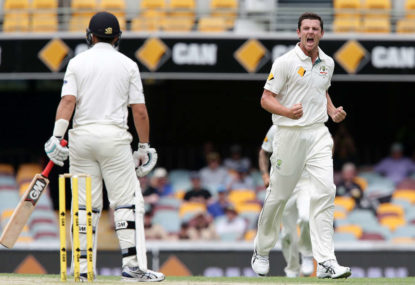'Big achievement': Jason Gillespie secures major appointment as Pakistan Test coach
Australian fast bowling great Jason Gillespie has been named head coach of Pakistan's Test team, as the nation overhauls its coaching department ahead of…

There was a time when a win to either Australia or New Zealand looked likely on this WACA pitch. Both teams were working hard and implementing their plans in a true contest between bat and ball.
But then the players concluded their warm-ups, got changed, lined up for the anthems and Tim Southee bowled the first ball of the match.
Of course, there are caveats. Australia’s fielders missed chances that they really, really needed to hang on to, and there was some ordinary bowling. Great bowling and fielding has a way of taking the pitch out of the equation.
Mark Craig has met two Australian Test grounds, and they have both hated him with the passion that makes you wonder if he offended them in a past life. By contrast, Australia’s batsmen have taken a liking to him.
New Zealand’s bowlers operated really well with a reverse-swinging old ball on Day 5. Several batsmen, especially David Warner and Ross Taylor, batted extremely well. Balls had to be changed at an almost heroically bad rate.
However, none of the caveats should be allowed to take away from the fact that the WACA pitch was far too flat. Any contrary protests deserve derision.
The ball did virtually nothing off the seam, save for when a small crack opened up in the later stages of the match, which meant batsmen could get away with using hard hands. Far from containing the type of pace and bounce Curtly Ambrose once used so effectively, balls died in mocking laughter in front of both slip cordons, before receiving a more permanent death when they were judged to be out of shape.
Once batsmen had finished de-ball shining, bowlers were pressed into an all too familiar chain gang service. It took exceptionally good spells or luck for bowlers to even look like taking even just one wicket.
The fact that flatter pitches have been a nationwide trend is why blaming drop-in pitches are something of a red herring. This is not an argument for pitches that go to the other extreme but consider this – if you were a neutral fan, which Tests in Australia would you definitely have wanted to attend with the benefit of hindsight since, say, 2000? Where both teams were consistently a chance of victory until the last ball of the match had been bowled.
In two such matches, 40 wickets were taken and there was never any hint of a declaration.
First, New Zealand’s nail-biting seven-run win against Australia at the Bellerive Oval in 2011. Second, Australia’s come-from-behind win in the 2010 New Year’s Test against Pakistan.
In neither match were bowlers punished for being bowlers by a horrendously flat pitch. In fact, both curators went too far the other way. I remember walking to the ground at the start of Day 2 of the Hobart match, an overcast day, with Australia 1-12 in response to New Zealand’s 150 and thinking, ‘New Zealand are actually on top here’.
There shouldn’t be any pitch in the world in which 150 is a par first innings score, although it is a lot more interesting than a pitch where the par score is 550. Otherwise, substandard bowlers can thrive, and the game would lose some of the attractions of batting and encourage too many batsmen whose primary purpose is to be a ball de-shiner.
What is needed is a fairer balance between bat and ball. Otherwise, fewer will be parting with their money to be at the ground and crucially, for the financial side of the game, fewer and fewer people will be likely to watch the matches on TV.
This could be true even for traditional fans of the game. Why would anyone bother parting with their money to watch a boringly bat-dominated Test, when they need not pay anything to watch a much more interesting if lesser quality Sheffield Shield match?
This is where day-night cricket could be a circuit-breaker. Pitches, in order to accommodate the pink ball, may have to have more grass on them. But even if they don’t, curators need to be given confidence that they won’t be punished if they provide a pitch that allows for a fair contest between bat and ball, only for substandard batting to lead to a three-day Test.
Otherwise, more Tests in Australia will be draws. And who would want to be a bowler then?
Don’t get your hopes up for a revival. But while there is no revival, it would also be unwise to be too optimistic in expecting more success in the subcontinent. While the IPL and the plethora of short-form cricket fills the void of playing different conditions somewhat, the chance to play on a wide variety of pitches, afforded to the great players of the Australian side in the 1990s and 2000s, is a major problem for Australian cricket.
The plurality of pitches in Australia, with the seaming and bouncy Gabba, the fastest pitch in the world WACA, the flat but spinning big late Adelaide, the traditional hard Melbourne pitch that often required grafting cricket, the spin-dominated SCG and the potential wildcard but normally flat Bellerive allowed for the flourishing of all of the arts of cricket.
Yet that has been gone for some time now.
It might be asking too much to get it back, but bowlers deserve better than the Test pitches that they currently have to toil on.
In the movie Holes, the juvenile prisoners are busy digging holes when a little cloud is seen near the mountains. One of the pleas for it to come a little closer is from Armpit and he says, “Please. All I’m asking for is a little shade.”
Please, cricket, bowlers are asking. All they’re asking for is a little shade.
Please.